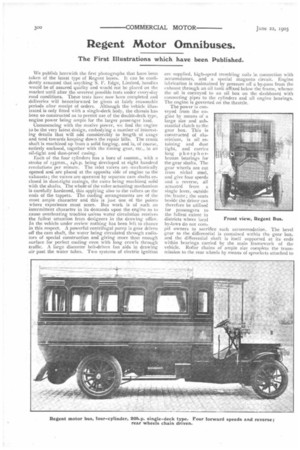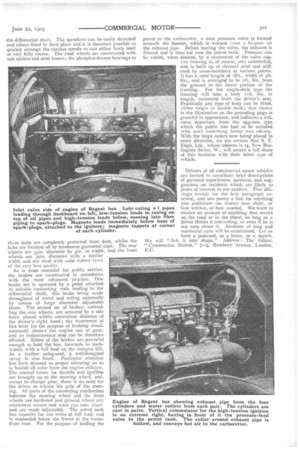Regent Motor Omnibuses.
Page 12

Page 13

If you've noticed an error in this article please click here to report it so we can fix it.
The First Illustrations which have been Published.
We publish herewith the first photographs that have been taken of the latest type of Regent buses. It can be confidently assumed that anything S. F. Edge, Limited, handles would be of assured quality and would not be placed on the market until after the severest possible tests under every-day road conditions. These tests have now been completed and deliveries will henceforward be given at fairly reasonable periods after receipt of orders. Although the vehicle illustrated is only fitted with a single-deck body, the chassis has been so constructed as to permit use of the double-deck type, engine power being ample for the larger passenger load.
Commencing with the motive power, we find the engine to be the very latest design, embodying a number of interesting details that will add considerably to length of usage and tend towards keeping down the repair bills. The crank shaft is machined up from a solid forging, and is, of course, entirely enclosed, together with the timing gear, etc., in an oil-tight and dust-proof casing. Each of the four cylinders has a bore of loomm., with a stroke of i35mm., 24h.p. being developed at eight hundred revolutions per minute. The inlet valves are Ancchanically opened and are placed at the opposite side of engine to the exhausts; the valves are operated by separate cam shafts enclosed in dust-tight casings, the cams being machined solid with the shafts. The whole of the valve actuating mechanism is carefully hardened, this applying also to the rollers on the ends of the tappets. The cooling arrangements are of the most ample character and this is just one of the points where experience must score. Bus work is of such an intermittent character in its demands upon the engine as to cause overheating troubles unless water circulation receives the fullest attention from designers in the drawing office. In the vehicle under review nothing has been left to chance in this respect. A powerful centrifugal pump is gear driven off the cam shaft, the water being circulated through radiators of special construction and giving more than enough surface for perfect cooling even with long crawls through traffic. A large diameter belt-driven fan aids in drawing air past the water tubes. Two systems of electric ignition
are supplied, high-speed trembling coils in connection with accumulators, and a special magneto circuit. Engine lubrication is maintained by pressure off a by-pass from the exhaust through an oil tank affixed below the frame, whence the oil is conveyed to an oil box on the dashboard with connecting pipes to the cylinders and all engine bearings. The engine is governed on the throttle. The power is conveyed from the engine by means of a large size and substantial clutch to the gear box. This is constructed of aluminium, is oil retaining and dust tight, and carries long phosphorbronze bearings for the gear shafts. The gear wheels are cut from nickel steel, and give four speeds and a reverse, all actuated from a single lever, outside the frame; the seats beside the driver can therefore be utilised for passengers to the fullest extent in districts where local by-laws do not compel owners to sacrifice such accommodation. The bevel gear to the differential is contained within the gear box, and the differential shaft is itself supported at its ends within bearings carried by the main framework of the vehicle. Roller chains of ample size complete the transmission to the rear wheels by means of sprockets attached to
Front view, Regent Bus.
the differential shaft. The sprockets can be easily detached and others fitted in their place and it is therefore possible to quickly arrange the various speeds to suit either fairly level or very hilly routes. The road wheels are constructed with oak spokes and steel bosses ; the phosphor-bronze bearings to these hubs are completely protected from dust, whilst the hubs are finished off by handsome gunmetal caps. The rear wheels are 33in. diameter by sin. in width, and the front wheels are 3oin. diameter with a similar width and are shod with solid rubber tyres of the very best quality. As is most essential for public service, the brakes are constructed in accordance with the most advanced practice. One brake set is operated by a pedal attached to suitable connecting rods leading to the differential shaft, this brake being made throughout of metal and acting externally by means of large diameter adjustable shoes. The second set of brakes, controlling the rear wheels, are actuated by a side lever, placed within convenient distance of the driver's right hand; the movement of this lever for the purpose of braking simultaneously throws the engine out of gear, and an instantaneous stop can be therefore effected. Either of the brakes are powerful enough to hold the bus, forwards or backwards, with a full load on the steepest hill. As a further safeguard, a well-designed sprag is also fitted. Particular attention has been devoted to proper silencing so as to banish all noise from the engine exhaust. The control levers for throttle and ignition are brought up to the steering wheel, and, except to change gear, there is no need for the driver to release his grip of the steering. All parts of the connecting mechanism between the steering wheel and the front wheels are hardened and ground where any movement occurs and wear can take place. and are made adjustable. The petrol tank has capacity for Too miles at full load, and is suspended below the frame at the immediate rear. For the purpose of leading the
petrol to the carburetter, a neat pressure valve is located beneath the bonnet, which is worked from a by-pass oft the exhaust pipe. Before leaving the valve, the exhaust is filtered and is then led into the petrol tank. Pressure can be varied, when desired, by a movement of the valve cap. 'Inc framing is, of course, very substantial, and is built up of channel steel and stiffened by cross-members at various points. It has a total length of t8ft., width of 3ft. 8in., and is arranged to be aft. Sin, from the ground to the lower portion of the framing. For the single-deck type the framing will take a body lift. 6in, in length, measured from the driver's seat. Practically any type of body can be fitted, either single or double deck; that shown in the illustration on the preceding page is graceful in appearance, and indicates a weL come departure from the egg-box type which the public has had to be satisfied with until something better was otterea. With the large orders now being placed in every direction, we are certain that S. F. Edge, Ltd., whose address is 14, New Burlington Street, W., will secure a full share of this business with their latest type of vehicle.
Drivers of all commercial motor vehicles are invited to contribute brief descriptions of personal experiences, opinions, and suggestions on incidents which are likely to prove of interest to our readers. Five shiL iings weekly tor the best paragraph received, and one penny a line for anything else published—no matter how short, or how written, or how worded. We want to receive an account of anything that occurs on the road or in the depot, so long as a driver thinks it interesting, or even if he is not sure about it. Accounts of long and successful runs will be entertained. Let us have a postcard, or a letter, or a sketch. We will "lick it into shape." Address : The Editor, "COMMERCIAL Mama," 7-15, Rosebery Avenue, London, E.C.
















